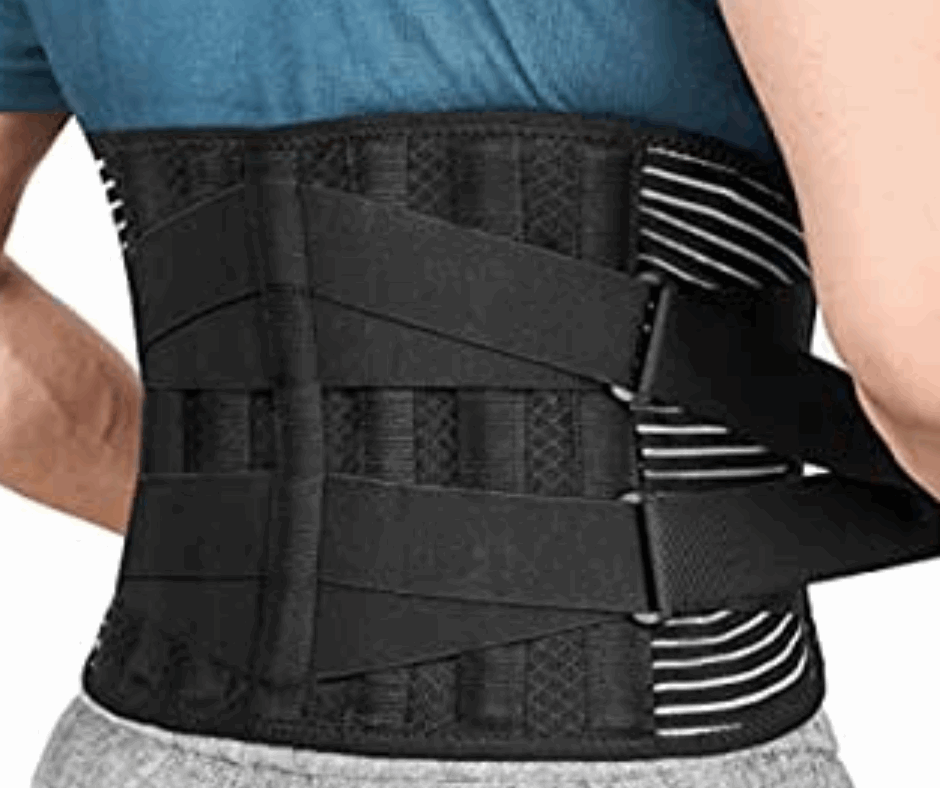1124. Waist Brace
1124. Waist Brace
Couldn't load pickup availability
DrSous.Ca
Waist Brace
|
Size |
L25,XL25 |
|
|
Age range (description) |
Adult |
|
|
Colour |
Black |
|
|
Material |
|
About this item
- 【TAKE PAIN AWAY IMMEDIATELY】 back brace contains 4 Memory-Aluminum stays which are 4X supportive than PP, and 2 steel springs placed along the waist side, providing 360° stronger support to lower back, relieving your lower back pain caused by arthritis,disc herniation,sciatica,spinal stenosis,scoliosis,and ankylosing spondylitis,fracture,etc.
- 【EXTRA SUPPORT TO PREVENT BACK INJURIES】The back support elastic straps are designed with 4 times stronger stretch yarns which easily add extra compression around back, keeping back safe while heavy lifting,long time standing or sitting, doing yard work, heavy shoveling, gardening,working ,etc.
- 【SUPERIOR STABILITY】 This back belt is installed with 2 Silicone anti-skid bands on the 2 sides of the waist, preventing the lower back brace from sliding up or folding when sitting, bending, crouching or doing daily activities. Along with 2 strong wide size velcro on the elastic straps, this lumbar back support belt provides maximum stability far beyond your expectations. Also It is made of PVC material that usually used for babies clothes,will not scratch your skin or damage your clothes.
- 【MOST BREATHABLE AIR MESH】To bring you an anultimate baby-skin-like silky touch, this back support brace is made of 4-way stretch tech, ultra breathable Air Mesh which is formed by 3D knitting technology at different compression levels. Perfect for wearing it under the cloths while recovering from back surgery.
- 【DURABLE & 100% FIRST CLASS SERVICE】The back brace for women adopts double seams and the quality is strictly controlled. Get your durable back brace for lower back support from here now. You have no risk to try this. Freetoo will provide a good all-around service for you all the time.
Research Study
A waist brace is a medical device that is designed to support the lower back and provide stability to the spine. It is a common tool used by people who suffer from lower back pain or have had a recent injury. In this article, we will explore what a waist brace is and how it works. We will also examine the benefits and drawbacks of using a waist brace and provide tips on how to choose the right waist brace for your needs. Whether you are an athlete or someone who works long hours at a desk, a waist brace may be a useful tool to help alleviate lower back pain and improve your quality of life.
A waist brace, also known as a back brace, is a device that is worn around the waist to provide support and stability to the lower back. It is commonly used in the treatment of lower back pain, as it helps to reduce the amount of stress placed on the lower back muscles and joints during physical activity. According to a study by WP Blount et al. (1958), waist braces are effective in reducing the amount of lumbar lordosis, or the inward curve of the lower spine, which can lead to lower back pain. The study found that wearing a waist brace for a period of six months resulted in a significant reduction in the degree of lumbar lordosis, as well as a decrease in the intensity of lower back pain. Waist braces work by providing additional support to the lower back muscles and reducing the load on the spine, which helps to reduce pain and inflammation. They are typically made from a combination of materials, including elastic, neoprene, and plastic, and can be adjusted to fit the individual wearer's body shape and size. While waist braces are not a cure for lower back pain, they can be an effective treatment option for individuals who experience chronic or acute lower back pain, as they can help to reduce pain and improve mobility.
Waist braces, also known as back belts or lumbar supports, are commonly used in workplaces where lifting and manual handling are required. According to Herlihy and Moss (1993), the use of waist braces has been shown to reduce the risk of lower back injuries caused by lifting heavy loads. The brace works by providing support to the lower back area, which can help to reduce the amount of strain placed on the muscles and ligaments in the back. Additionally, waist braces can help to promote proper lifting technique by reminding workers to lift with their legs and not their back. However, there are also drawbacks to using a waist brace. One potential issue is that the brace can create a false sense of security, leading workers to believe that they are protected from injury and may therefore take unnecessary risks. Additionally, prolonged use of a waist brace can lead to weakened back muscles, as the brace is taking on the load-bearing responsibilities that the muscles should be handling. It is important to note that waist braces should not be seen as a substitute for proper lifting technique and employee training. While they may provide some benefits in certain situations, they should not be relied upon as the sole means of preventing back injuries in the workplace.
According to Scardamalia and Bereiter (1994), choosing the right waist brace for your needs is crucial to ensure proper support and injury prevention. One of the first things to consider is the type of injury you are experiencing. Different waist braces are designed to support different areas of the body and provide varying levels of compression. For instance, if you are experiencing lower back pain, a lumbar support brace with a rigid structure may be more appropriate than a softer, more flexible brace. Additionally, it is important to consider the fit of the waist brace. A properly fitting brace should be snug but not too tight, as this can restrict movement and circulation. It is also important to choose a waist brace made from high-quality materials that are breathable and moisture-wicking to prevent skin irritation and discomfort during extended use. Finally, it may be useful to consult with a medical professional or physical therapist to determine the best waist brace for your specific needs and to ensure proper use and fit. By taking these factors into consideration, individuals can make an informed decision when choosing a waist brace that will provide the necessary support and protection for their unique needs.
In conclusion, a waist brace can be a helpful tool for those who suffer from back pain or injuries. While it is not a cure for these conditions, it can provide support and stability to the lower back, which can alleviate pain and discomfort. Additionally, waist braces can be beneficial for individuals who engage in physical activities that put a lot of strain on the back, such as weightlifting or heavy lifting. However, it is important to note that waist braces should not be worn for extended periods of time or without the recommendation of a medical professional. Overall, a waist brace can be a useful aid in managing back pain and promoting proper posture.
Work Cited
M Herlihy., JEB Moss."Transactional memory: Architectural support for lock-free data structures."https://dl.acm.org/doi/abs/10.1145/165123.165164
C Bereiter."Computer support for knowledge-building communities."https://www.tandfonline.com/doi/abs/10.1207/s15327809jls0303_3
"Making the Milwaukee brace."https://journals.lww.com/jbjsjournal/citation/1958/40030/making_the_milwaukee_brace.4.aspx
Share




